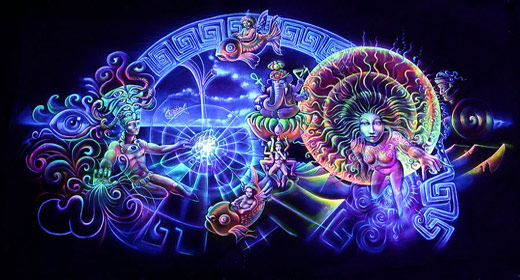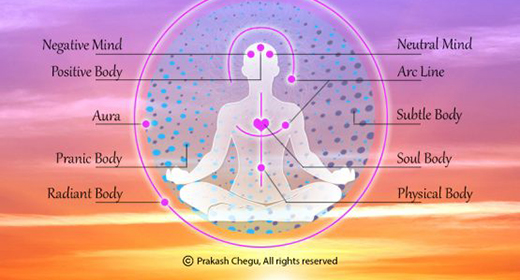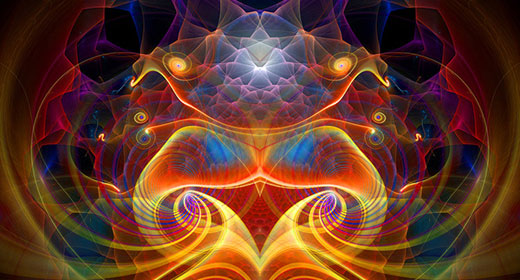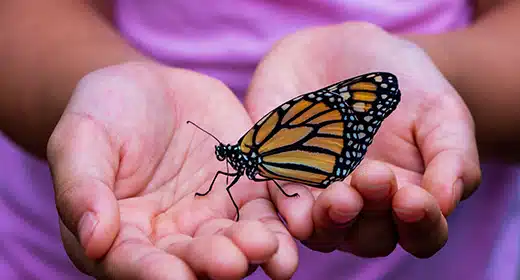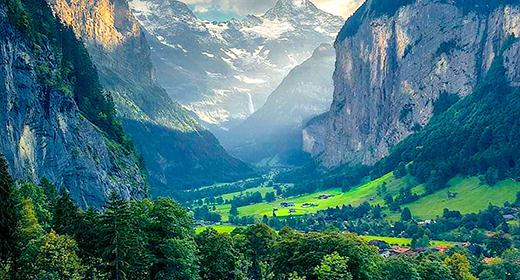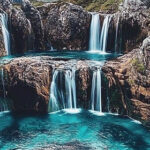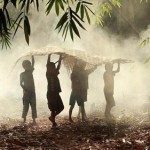by Dr. Stanley Krippner Ph.D. and Joseph Sulla: ABSTRACT: There has been little rigorous research on the spiritual content of ayahuasca sessions,  despite the tribal use of this herbal concoction and the existence of three Brazilian churches in which ayahuasca is considered a sacrament. The Casto Spirituality Scoring System, a reliable measure designed to identify spiritual content in dream reports, was utilized to answer the following question: “Is it possible to identify spiritual content in ayahuasca reports?” This system was found to be feasible in identifying “spiritual objects,” “spiritual characters,” “spiritual settings,” “spiritual activities,” “spiritual emotions,” and “spiritual experiences” in ayahuasca reports taken from pertinent literature. The Casto system defines “spiritual” as one’s focus on, and/or reverence, openness, and connectedness to something of significance believed to be beyond one’s full understanding and/or individual existence.
despite the tribal use of this herbal concoction and the existence of three Brazilian churches in which ayahuasca is considered a sacrament. The Casto Spirituality Scoring System, a reliable measure designed to identify spiritual content in dream reports, was utilized to answer the following question: “Is it possible to identify spiritual content in ayahuasca reports?” This system was found to be feasible in identifying “spiritual objects,” “spiritual characters,” “spiritual settings,” “spiritual activities,” “spiritual emotions,” and “spiritual experiences” in ayahuasca reports taken from pertinent literature. The Casto system defines “spiritual” as one’s focus on, and/or reverence, openness, and connectedness to something of significance believed to be beyond one’s full understanding and/or individual existence.
For millennia, indigenous cultures have used plant preparations in their spiritual ceremonies[1] to communicate with other-worldly spirits as well as to maintain their linkage with the natural world. Western culture severed this connection when Zoroaster banned the Haoma plant, when the Eleusinian rituals in Greece fell in disrepute, and when witches were persecuted by the Inquisition, in part because of their utilization of mind-altering substances. Western theologians and philosophers spoke of the necessity of humankind to dominate and manipulate nature; this “modern” worldview supplanted the “premodern” worldview with the latter’s position that human beings were part of nature, and separated from it at their peril.
What philosophers refer to as the “modern” worldview is responsible for impressive advances in technology, industry, and scientific discovery. However, it has not prevented (and may even have been partially responsible for) unprecedented fragmentation, nihilism, and devastation. As Berman (1984) states: “Western life seems to be drifting toward increasing entropy, economic and technological chaos, ecological disaster, and ultimately, psychic dismemberment and disintegration” (p. 1). However, the epoch of “modernity” may be in the process of being supplanted by the era of “postmodernity.” Some writers (e.g., Gergen, 1994) see “postmodernism” as a welcome corrective to the excesses of “modernism,” replacing its mechanistic and reductionistic assumptions and activities with those that are more organic and holistic in nature.
Metzner (1999b) calls for an “ecological postmodernism” that would include the ecological context of human life in psychology and other areas of contemporary inquiry. Drawing on such diverse sources as Native American rituals, the goddess cultures of pagan Europe, and the visions of Hildegarde von Bingen, Metzner holds that human beings must find their rightful place not as rulers, but as participants in the integral and interdependent community of all life (p. 166). Metzner sees modern Western civilization’s “war on Nature” as an exteriorization of intrapsychic conflicts, the “shadow side” of its preoccupation with its own imbalance and separation. For Metzner, human overpopulation, addiction to fossil fuels, preoccupation with material goods, and the resulting environmental degradation are psychopathological symptoms of a dissociation from the natural world. He sees the spread of religious rituals based on sacred plants as an aspect of “ecological postmodernism” that would contribute to sustainability, symbiosis, and the preservation of all life forms.
Reich, Oser, and Scarlett (1999) correctly point out that in postmodern times, the concept of spiritual development has come to mean something different than religious development. Indeed, several research studies have indicated a relationship between waking spiritual incidents and positive outcomes in individuals’ lives, such as psychological well-being and improved psychological attitudes (e.g., Hood, 1974; Kaas, Friedman, Lesserman, Zuttermeister, & Benson, 1991; Pollner, 1989) as well as individuals’ relationship to the world, e.g. investigating the purpose of life and their place in that purpose (e.g., Grof, 1988, p. 265; James, 1902/1958, p. 389). Contributing to this literature has been varied reports of purported spiritual experiences triggered by mind-altering brews and concoctions derived from plants. These experiences have been described, in the literature, through first person accounts, historical anecdotes, and ethnographic accounts.
AYAHUASCA
Furst (1976) suggests that the ritual use of mind-altering substances in the upper Amazon dates back to at least 3000 B.C.E. Serious Western research into the nature of these preparations began with the expeditions of Richard Spruce, an ethnobotanist who explored the Amazon and the Andes between 1849 and 1864; among the species he discovered was the Banisteriopsis caapi jungle vine (Rudgley, 1995, p. 64). In 1855 he observed that concoctions containing elements of this vine were ingested ritually. Reichel-Dolmatoff’s (1972, pp. 97-102) informants told him that concoctions containing this plant are used to “travel” to “other worlds” to visit their tribal divinities. In addition to the term ayahuasca, the brew is called yage(e’), caapi, kahpi, cadana, pinde, natem, natena, rami, and a variety of other names, depending on the tribe that uses it (Rudgley, 1993, p. 65; Schinzinger, 1999, p. 8). The term hoasca has been introduced not only to describe the sacred brew used by one of the ayahuasca-based religious groups in Brazil, but also as a descriptor in the ethnopharmacological literature (e.g., Callaway et al., 1999). Artifacts from Ecuador indicate that ayahuasca was known and used by indigenous groups there as far back as 2000 B.C.E.
The universal ingredient in all of these concoctions is Banisteriopsis caapi, often called the “vine of the souls,” but other plants such as Psychotria viridis, a leafy bush, must be added to potentiate its effect. However, some formulae are unique to one group of Indians residing in the Amazon and Orinoco River Basins, or even to a single shaman. Another factor compounding the accounting of the brews is the diversity in methods of preparations. The most commonly recorded processes involve either infusing Banisteriopsis bark in cold water or boiling the bark and/or the stems for long periods of time, adding other ingredients as is deemed appropriate (de Rios, 1975).
The chemical N,N-dimethyltryptamine (DMT) is found in several Amazonian plants (including Psychotria viridis), but it has no psychotropic effects when taken orally. This is due to the monoamine oxidase enzyme found in human saliva, which breaks down the chemical, rendering it inactive. The Banisteriopsis vine contains a variety of harmala alkaloids, type-A monoamine oxidase (MAO-A) inhibitors that are found throughout the body and counteract the effects of this enzyme, allowing DMT (and other substances normally inactive) to flow freely, binding to serotonergic sites in the brain. In addition to conferring activity on DMT, MAO-A inhibition may contribute to actions of other psychoactive substances sometimes found in the beverages (Callaway et al., 1999). For these reasons, thousands of plants have been used to produce ayahuasca brews with various effects.
For example, Rudgley (1993) has described the use of an ayahuasca-based concoction, caapi, by the Tukano Indians of the Colombian northwest Amazon. Consumption is restricted to males, and for specific ceremonies such as funerals, the diagnosis of ailments, and shamanic vision quests (p. 67). Several pieces of the fresh ingredients are cut, and then mashed to a pulp in a wooden trough to which cold water is then added. The mixture is strained and transferred to a specially decorated ceramic vessel, ideally made by an elderly woman, polished by a phallic-shaped stone, “purified” by tobacco smoke, and used exclusively for the drink by participants who have prepared themselves by a prescribed diet and a period of sexual abstinence. Ingestion is preceded by a recitation of creation myths and genealogies, accompanied by the sounds of a rattle and, later, flutes, whistles, singing, and dancing. The experient’s report usually begins with a description of phosphenes (circles, triangles, spirals, and other neurologically-based images) and later of such culturally-conditioned imagery as jaguars, snakes, and mythical landscapes (Reichel-Dolmatoff, 1987). The resulting condition is considered superior to one’s ordinary state of consciousness, and is reflected in artistic decorations, architectural designs, and the decorations found on Tukano pottery and musical instruments. Rudgley (1993) observes that the imagery reinforces key concepts and values in the Tukano cultural belief system.
Luna (1992), while conducting field work in the Peruvian Amazon in 1985, met don Pablo Amaringo, a former mestizo shamanic healer who showed him a series of exquisitely detailed landscapes he had painted. When asked how he had learned to paint, don Pablo replied that under the influence of ayahuasca he had been shown by the spirits how to combine colors to produce a panoply of hues. Luna was familiar with artwork stimulated by similar brews, and asked don Pablo if he would paint some of his ayahuasca visualizations. A few days later, don Pablo completed the first two such paintings, most of which related to Amazonian shamanism. Eventually, the two men collaborated on a book, Ayahuasca Visions (Luna & Amaringo 1991), which explores the iconography of 49 paintings which present hundred of animals, plants, spirits, and mythological beings. A comparison of don Pablo’s work with that produced by the Takano (Reichel-Dolmatoff, 1978), the Siona (Langdon, 1992), the Canelos Quicha (Whitten, 1981), and the Shipibo (Gebhardt-Sayer, 1984) demonstrates that the images are influenced by the individual’s cultural background. As such, they provide a great deal of relevant information about the artist’s culture and its guiding mythology (Luna & Amaringo 1991, pp. 43-44).
Dobkin de Rios (1992, p. 158) has chronicled the ritual use of ayahuasca by an urban shaman, Hildebrando, better known as don Hilde. Dobkin de Rios interviewed each of the 97 men and women seen by don Hilde during her field work in Pucallpa, Peru, the site of his office. She observed that the client plays an active role in the ayahuasca ritual: “Intrinsic to the drug effect is the power of the plant to evoke expressive experiences equal in force and drama to the best theatre available anywhere. The ayahuasca client’s particular experience during the healing ritual is multifold — he [or she] is actor, playwright, stage director, costumier, make-up artist and even musician. A fast-moving, brilliant kaleidoscope of colours, forms, geometric patterns, movement and counterpoint provides the most unique experience most individuals ever encounter in normal waking consciousness. This effect is produced entirely from within the individual’s own psyche. The stage manager throughout this is the healer. Through music, chants, whistling, or even percussion sounds, he [or she] evokes patterned visions which are important to the client. Again, these visions have been canalized by the client’s culture. From his earliest years, the Amazonian city resident or farmer hears discussions of ayahuasca use, listens while people who have partaken in these sessions analyze them in retrospect, and determines whether there has been an appropriate response to the drug. Dobkin de Rios (1992, p. 156) concludes that “the stereotyping of drug visions is not unusual” because there are specific expectations surrounding the session.
In Peru it is common for allopathic physicians to refer some of their patients to ayahuasceros (i.e., shamans who use ayahuasca) when they are unable to make a diagnosis, identify a problem, or find a cure. The ayahuasceros sing sacred songs or icaros, which call forth spirits who, in turn, are thought to attempt healing (Dobkin de Rios, 1992). In addition to the use of ayahuasca by Indian tribes through the Amazon (Schultes & Hofmann, 1980) the brew is utilized in at least three organized religious groups that consider it a sacrament: Santo Daime, Uniao do Vegetal, and Barquinha. Apart from the indigenous population, it has been estimated that there are at least 15,000 monthly users of ayahuasca within the urban populations of South America (Callaway et al., 1999). In 1987, the use of such beverages within a religious context was officially recognized and protected by law in Brazil, after lengthy investigations into its alleged threats to national security and public health (Ott, 1994). This was the first time in 1,600 years that a government had granted permission to its non-indigenous citizens to use a mind-altering substance in a religious context (McKenna, Callaway, & Grob, 1998).
Santo Daime traces its origins to Raimundo Irineu Serra, a 7-foot-tall Brazilian rubber tapper of African-Brazilian descent, who was born in the state of Maranhao in 1882. At the age of 20, Serra traveled to Acre, Brazil, to participate in the booming rubber trade. En route, he encountered several native tribes that allowed him to witness the manufacture of the ayahuasca brew. In one of his sessions with the natives, a woman calling herself the “Queen of the Forest” appeared to him. Irineu, who came from a Christian background, identified her with the Virgin Mary. The lady told him to enter the rainforest alone to prepare and drink the ayahuasca brew for eight days. Subsequent instructions were to spread her message throughout the world. ayahuasca was to be called, “daime” (i.e., “give me,” as in “give me love, give me light, give me strength”), because the lady insisted that this beverage was the sacred blood of Jesus Christ, and that it would give light, love, and strength to all who would use it.
When Irineu left the rainforest, he brought with him a complete structure for a Daime ceremony that consisted of a syncretic mixture of Amazonian, African, and esoteric Christian elements. The central focus for these Santo Daime ceremonies was the singing of hymns, which he claimed to have “received” while within the “force” of the Daime. In the 1930s, Irineu assembled a congregation in Rio Branco, in the Brazilian state of Acre. He could not read, write, or transcribe music but his hymns were soon put into written form by his followers. He became known as “Master Irineu,” the first great leader of the Santo Daime movement.
Initially, Santo Daime was a rural phenomenon (Richman, 1990-1991, p. 39). In recent decades, however, Santo Daime has maintained its centers in the rainforests and has established new assemblies in Brazilian urban areas (Larsen, 2000).
One of us (JS) has pent several months in Ceu do Mapia, a Daime community of several hundred people located in the southwest Amazon, on a tributary of the Purus River. Ceu do Mapia is equipped with a small hospital, a school, and a bevy of small wooden houses; rice, beans, and manioc are grown locally, chicken are bred and a few cows are raised for their milk, while bananas, cashew fruits, and lemons can be found in the nearby village. A large star-shaped church has been built at the village’s center, but small, focused healing takes place in a smaller building called the “Star House.”Feito, the ritualistic preparation of Daime, is a communal event, month-long festivals are held twice a year, while healing ceremonies are scheduled when needed.
The Star House is not the only place where spirit guides are incorporated or “channeled.” “White Table” works are held twice monthly (on the 7th and 27th of each month) at the church. There are several terreros where Umbanda works occur, and a “Santa Casa” (or “Holy House”) has been built where a great deal of healing through mediumship occurs. The spirits incorporated are not always benign; often, suffering, rebellious, or malignant spirits appear. A unique element of UmbaDaime (the synthesis of Umbanda and Santo Daime) is that these spirits are “illuminated” by giving themayahuasca.
There are an estimated 5,000 Daime members in Brazil (as well another 2,000-3,000 overseas members). There are several doctrinal groups, and many types of Santo Daime ceremonies. Typically, the ceremonies take place in church settings with a six-pointed table in the center. The ceremonies are typically called “works,” because participants attempt to work on their own spiritual evolution during each session. “Celebration works” are differentiated from “concentration works” and “healing works.” Each “celebration work” involves a period of highly structured singing and dancing, followed by an hour intermission, and concludes with another period of singing and dancing. Maracas, drums, guitars, and other instruments may be heard during the ceremonies. The songs and musical rhythms are designed to help participants focus on their “inner work,” aided by such symbols as the sun, moon, stars, the Star of David, and pictures of the Christian saints and Daime founders. In some centers, elements of other African-Brazilian religions such as Umbanda, as well as such spiritistic beliefs as those based on the writings of Allan Kardec, have found their way into the ceremonies. Every few hours, participants have the opportunity to imbibe the ayahuasca brew.
Master Irineu’s group grew steadily; many people followed him because he developed a reputation as a great healer. In the early 1950s, one of his most avid followers claimed to receive another series of visions from the Queen of the Forest, ordering him to establish a new branch of the Daime doctrine which incorporated more elements of Umbanda. This man became known as Master Daniel and his church was named Barquinha (or “Little Boat”).
[SOME PROBLEMS HERE. DANIEL RECEIVED HIS FIRST REVELATION WHEN HE WAS SLEEPING, DRUNK, ON A BEACH OF A IGARAPÉ, NEAR A HOLE CALLED “POÇO DAS COBRAS”. THERE HE HAD A DREAM WITH TWO ANGELS BRINGING HIM A BLUE BOOK.
AFTER THAT DREAM HE VISIT MESTRE IRINEU, WHO INVITE HIM TO BEGUN A TREATMENT (IT WAS THE YEAR OF 1936) WITH THE DAIME, WHAT DANIEL DID. BUT AFTER BECOMING WELL, HE JUST WENT BACK ON DRINKING, BUT HE KEPT GOING TO DRINK DAIME WITH IRINEU.
ONE DAY, GOING TO IRINEU’S TEMPLE, HE FELT VERY TIRED, AND DECIDED TO SLEEP HALF WAY FROM IRINEU’S TEMPLE, ON THE ROAD. THERE HE HAD A SECOND DREAM WITH THE TWO ANGELS BRINGING TO HIM A BLUE BOOK. THAT WAS THE DEFINITIVE CALL, AND DANIEL DECIDED STOPPING TO DRINK.
IN 1945 IRINEU FINALLY TOLD TO DANIEL THAT HE SHOULD HAVE HIS OWN SPACE TO WORK, AND TO CREATE HIS OWN “MISSION,” WHAT DANIEL DID. THIS IS THE OFFICIAL YEAR FOR THE FOUNDATION OF THE BARQUINHA, WHEN DANIEL CONSTRUCT A SMALL CHURCH (“capelinha”) TO RECEIVE THE PEOPLE THAT BEGUN TO VISIT HIM SEARCHING FOR HELP.
THE SOURCE OF THE NAME BARQUINHA IS CONTROVERSIAL: SOME SAY THAT IT WAS BECAUSE DAINEL WAS A SAILOR. HOWEVER, IT SEEMS THAT THE NAME BARQUINHA CAME AFTER DANIEL’S DEATH (1958), BECAUSE MANY OF HIS PSALMS HAVE THE SEA AS A BACKGROUND.
YOU CAN USE SENA ARAÚJO BOOK AS THE SOURCE FOR ALL THAT INFORMATION: Sena Araújo, W. (1999). Navegando nas ondas do Daime: História, cosmologia e ritual da Barquinha [Navigating at the waves of Daime: History, cosmology and ritual of Barquinha]. Campinas: Editora da Unicamp.]
In Barquinha, ceremonies center around a table shaped like a cross. Participants usually sit in contemplation for the first half of the ceremony, then began to dance with “spirits” summoned through carimbas [CURIMBAS] and pontos (sacred songs). The spirits summoned are also found in Umbanda — encontados (nature spirits), criancas (spirits of children), caboclos (spirits of those who descended from unions of Native Amazonians and Africans), pretos velhos (spirits of Africans sold into slavery or their descendants), and mermaids (representations of Iemanja, the African “Goddess of the Oceans” who protected the slaves on their hazardous journey to Brazil). Ayahuasca is served periodically during the ceremonies.
The “Uniao do Vegetal” (“Union of the Vegetal” or UDV), was founded in 1961 by another rubber tapper, Jose Gabriel Da Costa who had been trained in the manufacture of ayahuasca by the natives of the rainforest, and who later became known as Master Gabriel. When Gabriel first drank the cha misterioso (the mysterious tea), he knew of it as the cinema do Indio or Indian cinema, a term used by his fellow rubber tappers, many of whom had ingested the substance themselves. Gabriel was introduced to the tea by a rubber tapper who had a reputation of drinking the tea with one hand, sugar cane liquor with the other hand, and using the tea to seduce women (Schinzinger, 1999, p. 11).
During his first burracheira (i.e., the altered state of consciousness induced by ayahuasca), Gabriel was taken to the forest and shown how to identify the two plants used to prepare the tea. On the very next day, he and his son gathered the plants, prepared the tea, and drank it again with his wife. Over the next few years, Gabriel established the teachings given to him in the burracheira,combining them with his Portuguese Catholic roots, and the years he spent as a leader of Umbanda. He was also exposed to the writings of the French spiritualist, Allan Kardec, and the teachings of the Bolivian and Brazilian Indians with whom he tapped rubber and drank ayahuasca. Presently, UDV claims some 6,000 members who are distributed among at least 60 nucleos throughout Brazil (Luna & White, 2000; Metzner, 1999b).
UDV ceremonies focus around a table, with the Mestres (Masters) sitting in the middle. A series of chamadas or “calls” open the ceremony. Sacred readings from the writings of the church founders are read; often the “Mestres will give their reflections on these texts. A large portion of ayahuasca is served at the beginning of the ceremony, and then participants sit in silent meditation, sometimes with recorded music played in the background. Some Mestres sing hymns from the church repertoire. In the second half of the ceremony, participants share their reactions or ask the Mestresquestions about the session. Men and women were separated until the mid-1980s, and this practice persists in some congregations or nucleos. UDV sponsored the International Conference of Hoasca Studies in Rio de Janeiro in 1995, an event that attracted an international audience and received wide media coverage.
Master Irineu and Master Gabriel both died in 1971; they both tapped rubber in the same region but apparently never met. We(SK and JS) met an associate of Master Daniel, a Padrinho (or “godfather”) of Barquinha, in 1996 in Manaus at the 15th conference of the International Transpersonal Association. The theme of the conference was “Technologies of the Sacred,” and all threeayahuasca-based religions were discussed by several of the participants.
Grob et al. (1996) conducted a study of 15 male UDV church members, 11 of whom had diagnoses of alcohol abuse disorders and phobic disorders, with such symptoms as binge drinking and violent behavior before regular use of the tea. These subjects were interviewed three times over a two week period, and compared with 15 members of an age-matched control group of 15 non-UDV members. No harmful sequelae were observed and the 11 UDV members with pathological diagnoses had all remitted. A pharmacokinetic study of the same 15 Uniao do Vegetal church members by Callaway et al. (1999) found “no signs of physical or psychological deterioration,” and concluded that “the regular use of hoasca in a ceremonial context seems to increase one’s ability to psychologically adapt to the larger process of life” (p. 255).
In the summer of 1993, a group of biomedical researchers from the United States, Finland, and Brazil, met in the Amazonian city of Manaus to investigate the psychological and biomedical effects of ayahuasca. They conducted their study with members of the UDV church in Manaus who had used the substance regularly for at least 10 years. No negative effects were observed, but an increased density of serotonin uptake sites in blood platelets was detected (Callaway et al, 1994). The latter result was paradoxical because most psychotropic substances decrease serotonin. However, it provides a clue as to the therapeutic effects of ayahuasca because the serotonin system is deficient in violent alcoholics (Grob et al., 1996). Psychologically, the team found their subjects to be “more relaxed” than non-UDV members, and demonstrated “more purpose and direction in their lives,” and a greater concern for the preservation of the natural environment. A “hallucinogenic rating scale” was constructed, which placed ayahuasca on the mild end of the spectrum in contrast to intravenous DMT which was on the opposite pole.
However, this scale did not address the phenomenological contents of the ayahuasca sessions. What was needed was a different kind of research procedure that would make such a contribution. We decided upon content analysis to accomplish this objective because this method has been developed to systematically and objectively identify characteristics and themes of communications or documents and the relative extent to which these characteristics and themes pervade a given communication or document (Berg, 1989, p. 106; Holsti, 1968, pp. 597, 601; Weber, 1990, p. 9).
RESEARCH QUESTION
As there has been little rigorous research on the spiritual content of ayahuasca sessions, this research study was designed to answer the following question: “Is it possible to identify spiritual content in ayahuasca reports, and if so, how?”
DEFINITION OF TERMS
Several definitions were employed in this research study and guided its focus:
“Transpersonal studies” can be defined as disciplined inquiries into those observed or reported human behaviors and experiences in which one’s sense of identity appears to extend beyond its ordinary limits to encompass wider, broader, or deeper aspects of human, life, and/or the cosmos including purported divine elements of creation (Krippner, 1997).
The “divine” was defined as that which is regarded as holy (belonging to, derived from, or associated with religious or spiritual powers) and sacred (that which is dedicated to or worthy of veneration or worship) (American Heritage Dictionary, 1993), thus deserving the highest respect. The locus of the divine can be either outside of oneself, as when it has the nature of a superhuman entity or a deity, or within oneself, as when it is thought to reside within one’s “inner,” “deeper,” and/or “higher” self. “Reverence,” in this research, was defined as an attitude or feeling of profound awe and respect (American Heritage Dictionary, 1993).
Achterberg and Lawlis (1980) define “imagery,” as “the internal experience of a perceptual event in the absence of the actual external stimuli” (p. 27). Therefore, imagery in ayahuascaexperiences does not have to be visual, but can be auditory, olfactory, gustatory, or kinesthetic as well.
“Spiritual” was defined as one’s focus on, and/or reverence, openness, and connectedness to something of significance believed to be beyond one’s full understanding and/or individual existence (American Heritage Dictionary, 1993; Elkins, Hedstrom, Hughes, Leaf, & Saunders, 1988; Krippner & Welch, 1992, pp. 5, 122; Shafranske & Gorsuch, 1984, p. 233). There is an overlap between “spiritual” experiences and those referred to as “transpersonal,” “mystical,” or “religious,” but these are not regarded as synonyms. In “transpersonal” experiences, one’s sense of identity appears to extend beyond its ordinary limits; in “mystical” experiences, this extension appears to unite with something considered “divine,” “sacred,” or “holy”; in other words, all “mystical” experiences are “transpersonal,” but not all “transpersonal” experiences are “mystical.” In “religious” experiences there is a reported contact with something that an organized body of believers considers to be “divine,” “sacred,” or “holy.”
Definitions of “spiritual” and “religious,” and of “spirituality” and “religion” are often similar. For example, James (1902/1958) defines “religion” as “feelings, acts, and experiences of individual men [and women] in their solitude, so far as they apprehend themselves to stand in relation to whatever they may consider divine” (p. 42). However, this definition is very much like the definition of “spiritual” as given above, especially in its implied link between beliefs and action. Therefore, for clarity’s sake, “religion” or “religious” was distinguished in this research from “spiritual” as pertaining to, and adherence to, an organized system of beliefs about the divine, and the observance by a body of believers of rituals, rites, and requirements of that organized system of beliefs (American Heritage Dictionary, 1993).
“Shamans” can be defined as socially-sanctioned practitioners who deliberately alter their conscious functioning to obtain information not ordinary available to their peers, using this information in the service of their community (Krippner & Welch, 1992).
The term “entheogenic” has come into use to describe substances that purport to release one’s “inner divinity” (Roberts, 1999, p. 24). As such, the term is considered by many to be more precise that the terms “psychedelic” (i.e., “mind-manifesting”) and “hallucinogenic” (i.e., “mind-wandering”). Many writers claim that the latter term is not appropriate for ayahuasca sessions, few of which produce full-blown hallucinations. However, “psychedelic” can be viewed as an umbrella term that encompasses substances that evoke “entheogenic” experiences as well as the “sensory-perceptual,” “psychological-recollective/analytic,” and “symbolic-mythic,” levels of experience described by Masters and Houston (1966), and the “biographical-recollective” and “perinatal” levels of experience described by Grof (1985). Masters and Houston’s “religious-integral” and Grof’s “transpersonal” levels of experience could be regarded as “entheogenic,” but not everyone who ingests ayahuascareaches those levels. In the meantime, a case can be made for using such terms as “entheogenic” to describe experiences rather than substances, because not everyone ingesting ayahuasca and similar plant concoctions will have an “entheogenic,” “transpersonal,” or “spiritual” experience.(note 2)
INSTRUMENTATION
Hall and Van de Castle’s system of dream content analysis, with its predetermined categories and subcategories, is frequently used to detect common and recurring elements in dreams. While Hall and Van de Castle’s (1966) categories do not include spiritual categories per se, they do include categories that sometimes contain spiritual content items, e.g., physical surroundings, characters, social interactions, activities, achievement outcomes, environmental press, emotions, descriptive elements. The reliability of scoring, or consistency of measurement, was found by Hall and Van de Castle to be 73% for physical surroundings, 76% for characters, 70% for social interactions, 85% for activities, and 63% for emotions. Hall and Van de Castle’s original normative data has been replicated in other studies; for example, Hall, Domhoff, Blick, and Weesner (1982) found few differences between the normative data of Hall and Van de Castle’s original research and their own participants.
Kira Lynn Casto developed a “spirituality scoring system” to supplement Hall and Van de Castle’s work (Casto, 1995)(Figure 1). Named the “Casto Spirituality Scoring System” (CSSS), she modified several categories in Hall and Van de Castle’s (1966) system to identify spiritual content. Their “objects” category was altered to “Spiritual Objects”; their “Characters” category was altered to “Spiritual Characters”; their “Settings” category was altered to “Spiritual Settings”; their “Activities” category was altered to “Spiritual Activities”; their “Emotions” category was altered to “Spiritual Emotions.”
Hood’s (1975) Mysticism Scale was used to develop a “Spiritual Experiences” category yielding several possibilities, i.e., experiences in which there is a sense of direct contact, communion, or union with something considered to be ultimate reality, God, or the divine; experiences in which one’s sense of identity temporarily reaches beyond or extends past his or her ordinary personal identity to include an expanded perspective of humanity and/or the universe; experiences where one appears to enter a sacred realm or condition that goes beyond the ordinary boundaries of space and linear time.
The difference between “activities” and “experiences” is similar to the psychological differentiation between behavior (i.e., externally observable actions, including verbal behavior) and experience (i.e., lived events that are phenomenological reported). The phrase, “I was angry at God” would be scored for “spiritual emotion.” The phrase, “I told God that I was angry” would be scored for both “spiritual emotion” and “spiritual activity.” The phrase, “I was angry at God, and this reaction produced a red glow in my heart that sent intense heat throughout my body” would be scored for “spiritual emotion” and “spiritual experience.” The phrase, “I told God that I was angry, and this reaction produced a red glow in my heart that sent intense heat throughout my body” would be scored for “spiritual emotion,” “spiritual activity,” and “spiritual experience.”
Some dreams contain religious content but not spiritual content. A Brazilian woman reported that, in her dream, I found a place with perfumes and soaps. There were some gifts that I had received from my older brother. Someone gave me a little car and a doll. Someone else showed me a chain made of sandalwood which was very sweet-smelling. I received two blue envelopes that were sealed. Then I designed a chapel, a little church in a unique style which would be used only for weddings. This dream could be scored for “religious content” because of its references to a chapel, church, and weddings. However, none of these meet the criteria for “spiritual content” as outlined in the CSSS.


